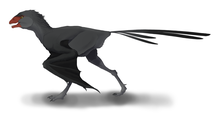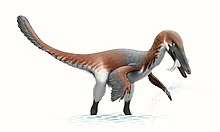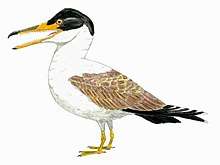Longipterygidae
Longipterygidae is a family of early enantiornithean birds from the early Cretaceous Period of China. All known specimens come from the Jiufotang Formation and Yixian Formation, dating to the early Aptian age, 125-120 million years ago.[2]
| Longipterygids | |
|---|---|
| Fossil specimen of Longipteryx chaoyangensis, Hong Kong Science Museum | |
| Scientific classification | |
| Kingdom: | Animalia |
| Phylum: | Chordata |
| Clade: | Dinosauria |
| Clade: | Saurischia |
| Clade: | Theropoda |
| Clade: | †Enantiornithes |
| Family: | †Longipterygidae Zhang et al., 2001 |
| Type species | |
| †Longipteryx chaoyangensis Zhang et al., 2001 | |
| Genera | |
| Synonyms | |
| |
Description
Longipterygids are characterized by an extremely long, toothed snout (making up over 60% of the total skull length), in which the teeth are restricted to the tips of the jaws. The snouts were straight but slightly concave at a point behind the nostrils, and the bones of the snout tip were solid. Their pygostyles, the series of fused vertebrae in the tail, were unusually large, and longer than the foot bones. The feet of longipterygids were also specialized relative to other Enantiornithes. Where most Enantiornithes had a long middle toe with a "knuckle" (trochlea) that extended beyond the outer two, the toes of longipterygids were even in length, and attached to the rest of the foot at the same level. This configuration is also seen in some groups of modern birds and is usually considered an adaptation for advanced perching ability. It is likely that longipteryigids lived primarily in trees. Because their long jaws tipped with large, often curved teeth are usually considered an adaptation for catching and eating fish, it is likely that they were similar in ecology to modern Kingfishers.[3] Other interpretations of their habitus include mud-probing and the probing for insects behind tree bark.[2]
Classification
The Longipterygidae was first coined as a family of enantiornithean birds by Zhang and colleagues in 2001. They included only the first known species, Longipteryx chaoyangensis, and placed the family in its own order, Longipterygiformes.[4] While Longipterygiformes has never been formally defined, Longipterygidae was given a phylogenetic definition by O'Connor and colleagues in 2009. They defined the clade to include Longipteryx, Longisrostravis, their most recent common ancestor, and all of its descendants.[5]
The cladogram below was found in the phylogenetic analysis of O'Connor, Gao and Chiappe (2010a).[6]
| Longipterygidae |
| |||||||||||||||
Subsequently, the following cladogram was found in the phylogenetic analysis of Li et al (2012):[7]
| Longipterygidae |
| ||||||||||||||||||
References
- Li Li, En-pu Gong, Li-dong Zhang, Ya-jun Yang and Lian-hai Hou (2010). "A new enantiornithine bird (aves) from the Early Cretaceous of Liaoning, China". Acta Palaeontologica Sinica. 49 (4): 524–531.CS1 maint: uses authors parameter (link)
- Morschhauser, E. M., Varricchio, D.J., Gao, C., Liu, J., Wang, Z., Cheng, X. and Meng, Q. (2009). "Anatomy of the Early Cretaceous bird Rapaxavis pani, a new species from Liaoning Province, China". Journal of Vertebrate Paleontology. 29 (2): 545–554. doi:10.1671/039.029.0210.CS1 maint: multiple names: authors list (link)
- O'Connor, J.K., Zhou Z. and Zhang F. (In press). "A reappraisal of Boluochia zhengi (Aves: Enantiornithes) and a discussion of intraclade diversity in the Jehol avifauna, China." Journal of Systematic Palaeontology, (published online before print 16 December 2010). doi:10.1080/14772019.2010.512614
- Zhang, Zhou, Hou and Gu, (2001). "Early diversification of birds: Evidence from a new opposite bird." Chinese Science Bulletin, 46(11): 945-950.
- Jingmai K. O'Connor; Xuri Wang; Luis M. Chiappe; Chunling Gao; Qingjin Meng; Xiaodong Cheng & Jinyuan Liu (2009). "Phylogenetic Support for a Specialized Clade of Cretaceous Enantiornithine Birds with Information from a New Species". Journal of Vertebrate Paleontology. 29 (1): 188–204. doi:10.1080/02724634.2009.10010371.
- O'Connor, J.K.; Gao, K.-Q.; Chiappe, L.M. (2010). "A new ornithuromorph (Aves: Ornithothoraces) bird from the Jehol Group indicative of higher-level diversity" (PDF). Journal of Vertebrate Paleontology. 30 (2): 311–321. doi:10.1080/02724631003617498.
- Li Li; Wang Jinqi; Zhang Xi; Hou Shilin (2012). "A New Enantiornithine Bird from the Lower Cretaceous Jiufotang Formation in Jinzhou Area, Western Liaoning Province, China". Acta Geologica Sinica. 86 (5): 1039–1044. doi:10.1111/j.1755-6724.2012.00729.x.



.png)





.png)


